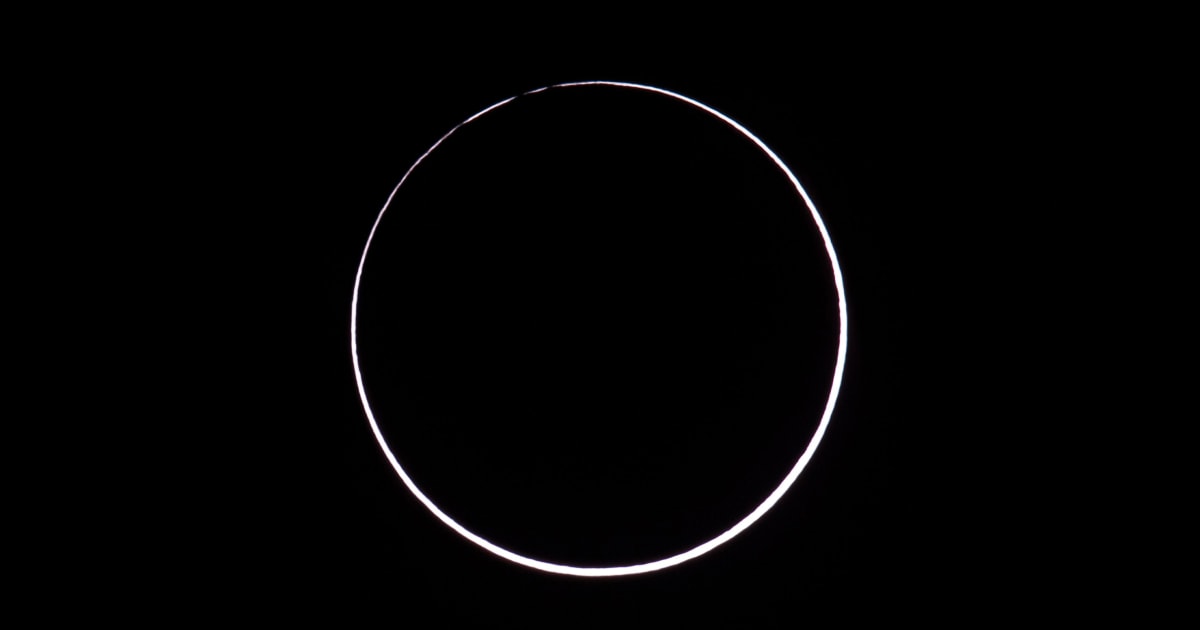
A spectacular solar eclipse will be visible across the entire continental U.S. this weekend, offering people from coast to coast the chance to see the moon take a “bite” out of the sun and affording lucky sky-watchers in nine states the opportunity to witness a rare “ring of fire” in the sky.
The astronomical event will take place Saturday. Weather permitting, sky-watchers in Oregon, Nevada, Utah, New Mexico and Texas, as well as slivers of California, Idaho, Colorado and Arizona, will be able to see the moon almost completely cover the sun, creating the effect of a fiery, orange-hued ring around the moon’s shadow. In all other states in the continental U.S., viewers will be treated to a partial solar eclipse, with the moon obscuring only part of the sun in the sky.
Solar eclipses are the results of cosmic confluences, occurring when the moon passes in front of the sun and temporarily blocks its light. Saturday’s event is what’s known as an annular solar eclipse — “annular” means “ring-shaped” in Latin.
People should never gaze directly at the sun during a solar eclipse, even when it is partly or mostly covered by the moon. Special eclipse glasses or pinhole projectors are required to safely view solar eclipses and prevent eye damage.
On Saturday, sky-watchers along a roughly 125-mile-wide path that cuts from Oregon south to Texas and through Central and South America will be able to see the full “ring of fire” effect. Most people in North America outside the “path of annularity” will see a partial eclipse if skies are clear.
Sky-watchers in Oregon will be able to see the start of a partial eclipse at 8:06 a.m. PT. The period of annularity, when the “ring of fire” effect is visible, will last around 5 minutes. During that time, the point of maximum coverage for people in Eugene, Oregon, will occur at 9:18 a.m. PT. Maximum coverage will be at 9:20 a.m. PT in Alturas, California; at 9:23 a.m. PT in Battle Mountain, Nevada; at 10:28 a.m. MT in Richfield, Utah; at 10:35 a.m. MT in Albuquerque, New Mexico; and 11:54 a.m. CT in San Antonio.
Saturday’s eclipse is a much-anticipated astronomical event because it’s rare for the path of a solar eclipse to cut so cleanly across the continental U.S., said Diana Hannikainen, an editor at Sky & Telescope, a monthly magazine about science and amateur astronomy.
“It’s an amazing sight to see this black, lunar disc silhouetted against the brighter solar disk,” she said, adding that if it’s feasible to travel to a place along the path of annularity, it’s “worth taking a peek, because just seeing this event reminds us that we live in a solar system that’s constantly in motion.”
Solar eclipses in general are considered precious sky-watching events because each one is viewable from only a limited part of the planet’s surface.
The entire course of a solar eclipse can last up to around three hours as the moon crosses in front of the sun.
In April, a total solar eclipse — when the moon completely blocks the face of the sun — will be visible from the U.S., Canada and Mexico.
Sky-watchers in the U.S. who miss Saturday’s event will have longer to wait for the next “ring of fire” spectacle: The next annular solar eclipse that crosses part of the U.S. will not occur until June 2039. But, Hannikainen said, the path of annularity for that one will only cut across Alaska. The next annular solar eclipse that crosses over the contiguous U.S., she said, isn’t until February 2046.
“So to have something that crosses coast to coast like this one does, from the Pacific Coast to the Gulf Coast, is really worth trying to see,” she said.
Source: | This article originally belongs to Nbcnews.com









